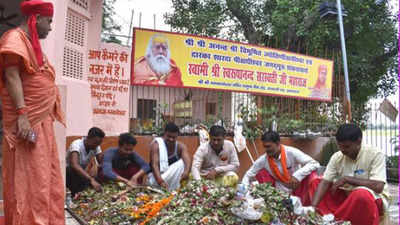- News
- City News
- allahabad News
- City temples turning floral and puja waste into compost in Uttar Pradesh's Prayagraj
Trending
This story is from July 23, 2021
City temples turning floral and puja waste into compost in Uttar Pradesh's Prayagraj
The city-based temples generate tonnes of flower waste, and the problem gets bigger during the pious month of Shrawan and the Navratri festival. However, the management of the city’s famous Mankameshwar temple has devised a plan to address the flower waste problem by setting up an in-house composting unit for the disposal of waste.

The chief priest of Mankameshwar temple, Brahmachari Sridharanand said, “we have devised a novel plan of tackling temple floral and puja waste and turning it into compost"
PRAYAGRAJ: The city-based temples generate tonnes of flower waste, and the problem gets bigger during the pious month of Shrawan and the Navratri festival. However, the management of the city’s famous Mankameshwar temple has devised a plan to address the flower waste problem by setting up an in-house composting unit for the disposal of waste.
The chief priest of Mankameshwar temple, Brahmachari Sridharanand told TOI, “we have devised a novel plan of tackling temple floral and puja waste and turning it into compost with the help of natural substances”.
He added, “Initially, a Kanpur based Agro unit was handling the disposal of floral waste, leaves and garlands but the employees of the unit stopped working during the corona pandemic and following which, the temple staff devised a plan to convert floral and puja waste into compost.”
“With Shrawan month fast approaching and the strength of devotees offering flowers, garland and leaves of various species of plants to Lord Shiva during the pious month will be increasing manifolds, producing several tonnes of flower waste, we would be taking the flower waste, leaves and garlands to our gaushala and making our effort to turn it into natural compost,” said Sridharanand. “We would be offering natural compost to devotees including farmers free of cost to grow fruits and flowers,” he added.
Moreover, the management committee of the bade Hanuman temple is also turning flower waste into natural fertilizer.
Swami Anand Giri of lord Hanuman temple said, “we are using the simplest form of composting at our fields and getting the natural fertilizers to grow plants and vegetables”.
Experts claimed that the flower waste, leaves and garlands were placed in bins at the fields and gaushalas. After a few months, the lowest layer decomposes and turns into black powder. This compost and can be used as manure, they explained. “This is a completely zero maintenance process and everything is on nature here,” they added.
The fact is, most of the city’s prominent temples, to tackle the floral waste issue, have now started turning floral and kitchen waste generated in their premises into compost. Temple authorities also claimed that they have ideas about composters, that were being installed at many temples in southern states but we have opted for the natural process to decompose the flower waste.
The chief priest of Maa Kalyani Devi temple, Shyam Pathak says, “the volume of flower waste increases manifolds during the festive season and we then make suitable arrangements for its natural disposal.”
The chief priest of Mankameshwar temple, Brahmachari Sridharanand told TOI, “we have devised a novel plan of tackling temple floral and puja waste and turning it into compost with the help of natural substances”.
He added, “Initially, a Kanpur based Agro unit was handling the disposal of floral waste, leaves and garlands but the employees of the unit stopped working during the corona pandemic and following which, the temple staff devised a plan to convert floral and puja waste into compost.”
“With Shrawan month fast approaching and the strength of devotees offering flowers, garland and leaves of various species of plants to Lord Shiva during the pious month will be increasing manifolds, producing several tonnes of flower waste, we would be taking the flower waste, leaves and garlands to our gaushala and making our effort to turn it into natural compost,” said Sridharanand. “We would be offering natural compost to devotees including farmers free of cost to grow fruits and flowers,” he added.
The process is simple. The volume of leaves, flowers and garlands from the temple waste is collected into bins. The garbage goes either to the landfills or big drums which has the system of soaking water and adding natural substances, turning the waste into organic after a certain period and produce clean manure,” informed the chief priest of Mankameshwar temple. “Many people arrive at temple premises to seek natural compost to grow plants,” he added.
Moreover, the management committee of the bade Hanuman temple is also turning flower waste into natural fertilizer.
Swami Anand Giri of lord Hanuman temple said, “we are using the simplest form of composting at our fields and getting the natural fertilizers to grow plants and vegetables”.
Experts claimed that the flower waste, leaves and garlands were placed in bins at the fields and gaushalas. After a few months, the lowest layer decomposes and turns into black powder. This compost and can be used as manure, they explained. “This is a completely zero maintenance process and everything is on nature here,” they added.
The fact is, most of the city’s prominent temples, to tackle the floral waste issue, have now started turning floral and kitchen waste generated in their premises into compost. Temple authorities also claimed that they have ideas about composters, that were being installed at many temples in southern states but we have opted for the natural process to decompose the flower waste.
The chief priest of Maa Kalyani Devi temple, Shyam Pathak says, “the volume of flower waste increases manifolds during the festive season and we then make suitable arrangements for its natural disposal.”
End of Article
FOLLOW US ON SOCIAL MEDIA











